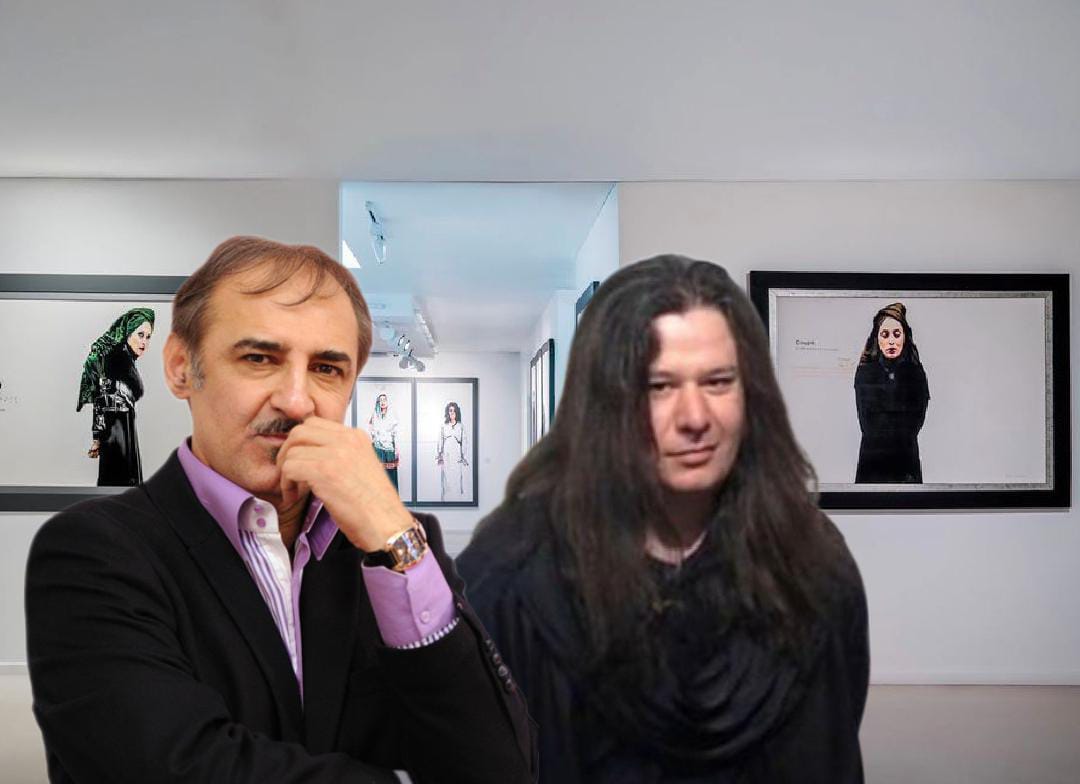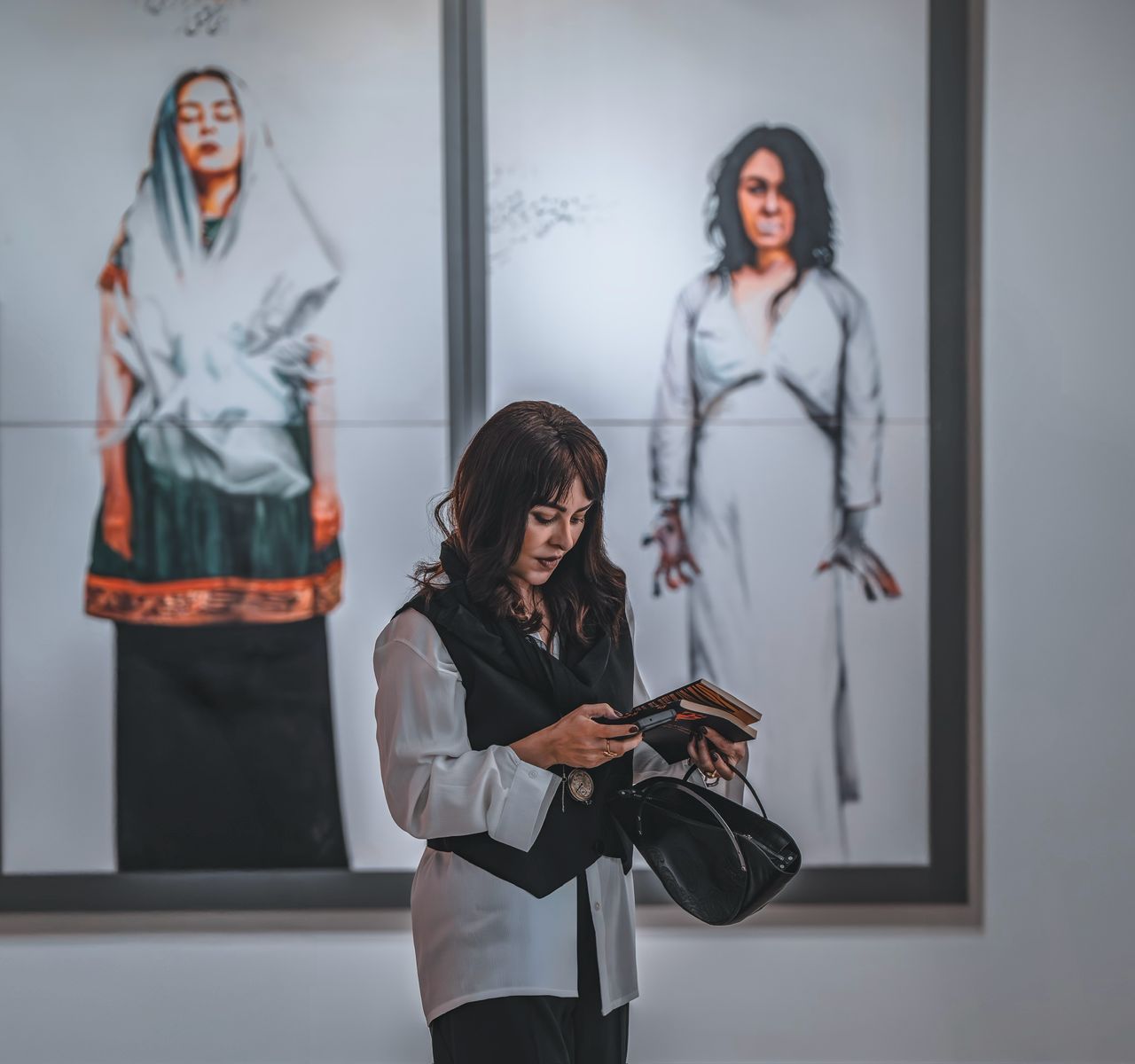
Alireza Samiazar and a Different Reading of the Works of Afshin Pirhashemi
Afshin Pirhashemi is among the most influential contemporary artists of Iran… The women in his paintings stood apart from all other depictions created by Iranian painters.
ArtDayMe :Dr. Alireza Samiazar — a distinguished figure in Iranian art and a lecturer in contemporary art history — has written an essay for the first exhibition of Afshin Pirhashemi [August 1974 – December 2024], held posthumously at Boom Gallery following his sudden passing at the age of 50.
The essay, titled “Fear and Solitude,” has been published in the exhibition catalogue; the full text follows below :
Afshin Pirhashemi is one of the most influential contemporary Iranian artists. Over the two decades of artistic activity, he earned widespread recognition through his exhibitions, awards, auction records, and, above all, his distinct artistic persona. He rose to prominence in the early 2000s with his black-and-white portraits of young female figures that appeared silent yet melancholic and confrontational. In terms of representations of women, these paintings differed from other Iranian painters’ works and are now considered as pioneering examples of a contemporary neo-expressionist movement. The female figures often emerge against empty backgrounds, critical in tone and indifferent to the modernist conventions of color, composition, and form. Alongside the works of some of his contemporaries, Pirhashemi’s paintings signaled the emergence of a new trend in Iranian conceptual painting. In his work, women do not appear in clearly defined temporal or spatial contexts. They often gaze directly at the viewer with a questioning look, challenging prevailing stereotypes and judgments. These portraits marked the first broad representation of the female figure in Iranian painting that lacked poetic or romantic undertones. In some cases, they even offered a cynical and sarcastic critique of contemporary ideals of femininity.

The idea of painting female figures has been persistently pursued across various periods and styles by great Western artists such as Auguste Renoir, Pablo Picasso, and Willem de Kooning. However, the most prominent artist to focus almost exclusively on women’s portraits throughout a significant part of his artistic career was Amedeo Modigliani. Using soft, elongated lines, he created countless images of women imbued with beauty and deep emotion. In all these cases, the female models were emotionally present in the artist’s personal life. Similarly, the idea of women in Pirhashemi’s paintings likely stems from his lived experiences, particularly in relation to the opposite sex. Yet from another perspective, this concept may be interpreted as the artist’s broader vision of life’s temptations, desires and doubts through the lens of womanhood—a concentration of dreams, nightmares, triumphs, and failures embodied in the female form. His women are not allusions to Freudian sexual instincts, but rather carry a symbolic quality aligned with a Jungian view. These fairy-faced women are not representations of the mother or lover, nor icons of affection or sexual allure. Instead, they reflect the anima—the feminine aspect of a man’s unconscious. In other words, they should be seen as mirrors in which the male self is reflected and hence, a deeper understanding of himself can be explored. In this way, Pirhashemi’s portrayal of the female figure becomes a reconstruction of hidden aspects of his own being; things that allude to pleasure and disgust, as well as his deepest anxieties and fears.
Regardless any interpretation, Pirhashemi’s artistic vision quickly inspired other artists of his generation, sparking a widespread movement in contemporary Iranian painting. His works demonstrated several distinctive features that placed them at the forefront of this wave of female portraiture. First, his completely black figures appeared on nearly empty canvases, in an imaginary and allegorical setting devoid of any specific implication of space and time. Second, a symbolic object or graphic motif was often included to underscore the allegorical dimension of the painting. These elements range from guns and knives to luxury car logos, reinforcing the semiotic language of the work. Third, he boldly incorporated written text—ranging from advertising slogans to verses from Rumi—creating a form of intertextuality that deepens the conceptual layers of his art.
In early experimentations, Pirhashemi worked on medium-sized canvases, usually featuring a single figure. Over time, the number of female figures increased, and the canvases became larger—sometimes triptychs—adopting more complex compositions. In certain cases, a single model was used for repeated figures in three separate panels, showcasing various aspects of personality. A notable example is the large triptych entitled Storm (2011), which depicts three sword-wielding women charging forward, leading a legion of armed female warriors. The turbulent background includes mountains and a raging river, with the Statue of Liberty bent over, seemingly on the verge of collapse. This cinematic scene emphasizes a blindfolded woman in the foreground—exhausted and desperate—supported by two other women. The blindfolded woman, a recurring motif in the artist’s later works, alludes to uncertainty and ambiguity regarding the future of social movements—a symbol largely absent from his earlier pieces. In Pirhashemi’s early works, compositions were often unbalanced with large empty spaces, highlighting the dynamic energy of the image and the instability of the figures’ condition. However, his later compositions—mostly exhibited outside Iran—are more balanced, drawing their vitality from the movement and posture of the figures. Unlike his earlier works, the later paintings are visually deeper, relatively more crowded, and rarely empty.

While his early works were mostly in black and white, color was gradually appeared, albeit cautiously, in his paintings. Nevertheless, Pirhashemi’s style never fully transitioned into realistic figuration with naturalistic colors. Although he always painted his figures based on photographic references, he never aimed for photo-realistic depiction. Instead, he emphasized painterly qualities by blurring backgrounds, exposing brushstrokes, limiting the color palette, and using texts and graphic elements. In almost all his works, Pirhashemi portrayed young women, usually with makeup and dressed in alluring black clothing. He often used attractive models, including well-known Iranian actresses, to present allure as an integral part of female power. However, in his works, these faces do not appear familiar; he effectively defamiliarizes his celebrity models.
Pirhashemi shows a distinct preference for full-length images of standing figures. Only in a few pictures are the women shown seated on couches or chairs. This choice to depict women in long-shot suggests a broader approach: he embodies womanhood in general, rather than individual woman. Even when using familiar women—such as his wife or movie stars—their personal traits are not the focus. These women are devoid of any dramatic emotion; their expressions are vague and rarely display laughter, tears, anger, or happiness. Only in portraits related to the protest movement of Iranian women do we see them shouting. In contrast to these silent figures, the artist uses objects to add conceptual meaning to the portraits and figures. Within his visual semiotics, these metaphorical objects help evoke meaning. Clothing often transcends social class, signaling the individuality and confrontational stance of these women. In some cases, full-body black leather outfits allude to a fetishized view of the female body. Other recurring objects include microphones, swords, guns, cars, and iconic Western buildings. Alongside these, animals such as horses, dogs, and cats appear close to the figures—not as literal companions, but merely as symbolic presences. These animals are never fully rendered; only parts of their bodies are shown, reinforcing their metaphorical function.
In addition to objects, logos and advertising slogans appear in some works to emphasize the artist’s ironic tone and sarcastic language. Among them, the BMW logo and its accompanying promotional text recur frequently. The juxtaposition of a car brand with the adorned face of a modern woman evokes the increasing commodification of women in consumerist societies. In such instances, Pirhashemi’s paintings approach the language of Pop Art—perhaps possessing a commercial motive as well. Having managed an art gallery in Tehran for a while, Pirhashemi clearly considered his audience’s tastes and the art market as a whole in both his early and later choices—from painting small, sparse, black portraits of women for Tehran’s art scene, to creating large, colorful, and crowded canvases to be exhibited in Dubai and London. In this regard, too, he has served as a source of inspiration for young Iranian artists.


The selected exhibition of works by Afshin Pirhashemi at Boom Gallery, Valiasr Street, north of the Niayesh intersection, Najaf Daryabandari Street [Armaghan-e Gharbi], No. 11, runs until December 18.

LEAVE A RELPY